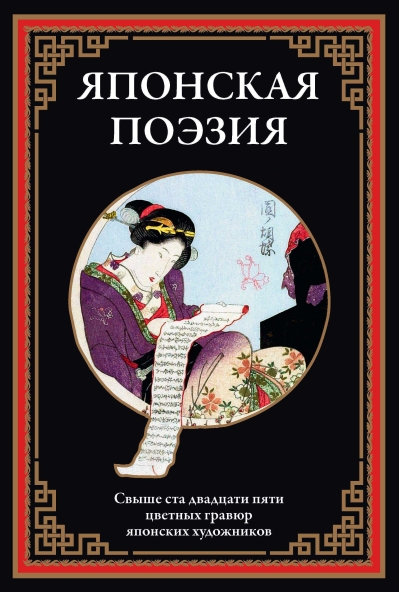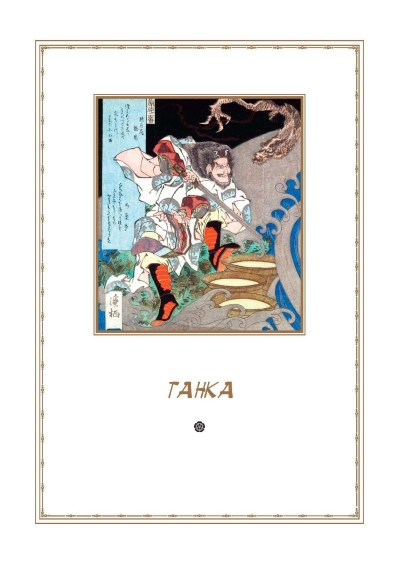Japanese poetry
14.99 €
Out of stock
The collection features tanka and hokku by more than 180 authors, including those whose works were included in the famous anthology Hyakunin isshu (One Hundred Poems by One Hundred Poets). This anthology is included in the book in its entirety. The original of each poem is given in Russian transcription, followed by one or more translations with commentaries that give an idea of both the author and the circumstances in which the lines were written. Almost every poem in the collection is illustrated with an original Japanese print. These drawings include works by such masters as Hokusai, Yoshitoshi, Hiroshige, and Harunobu, making this anthology a unique publication.
Traditional Japanese culture displays many amazing phenomena in architecture, painting, literature, and applied arts. Poetry, with its short forms of tanka and hokku, is no exception. It may seem strange to the Western reader how one can admire poems that have only five lines, or even three, and no rhymes at all. Moichi Yamaguchi, a Japanese poet, translator, and literary scholar of the 20th century, in his book on Japanese poetry, compares such traditional verse composition to impressionism in European art. The lines of a hokku are like three points on which the entire landscape they describe, which appears in the reader's mind, is held steady. The eminent seventeenth-century Japanese poet Takarai Kikaku once wrote a hokku like this: "A little frog is swinging, swinging // On a banana leaf // A little frog". What are these lines about? About the transience of life? About the perseverance with which one must face adversity? About how small we are compared to the formidable forces of nature? Each reader may have his or her own associations. The specificity of tanka and hokku is also in the fact that many of their characters have several meanings, which gives rise to a play of meanings and causes the reader rich allusions. That is why traditional Japanese poetry is so difficult to translate. The personality of the author and the circumstances in which the lines were written are important to its full perception. This collection of tanka and hokku by more than 180 authors provides such commentary. The original of each poem is given in Russian transcription, followed by one or more translations with commentary. Among the translators are not only poets (Balmont, Bryusov) but also prominent orientalists, including Vasily Melentievich Mendrin, who lived in Japan for several years and studied in graduate school at Tokyo Imperial University. Another feature of this book is its magnificent illustrations. Each poem is accompanied by a color drawing. The authors of these unique creations are such great Japanese masters as Utagawa Hiroshige, Toyohara Chikanobu, Kitagawa Utamaro, Suzuki Harunobu, Utagawa Kunisada and other artists. Among them is Tsukioka Yoshitoshi, often called the last outstanding master of traditional Japanese ukiyo-e prints. Eye-pleasing colors, unusual compositions, bold angles - everything in the book's drawings attracts the viewer's attention. The combination of the richest illustrative series with detailed commentaries and an excellent selection of poetry authors, including emperors, tsardars, warriors, Buddhist monks, famous poets and poetesses, makes this book a truly unique edition.
Traditional Japanese culture displays many amazing phenomena in architecture, painting, literature, and applied arts. Poetry, with its short forms of tanka and hokku, is no exception. It may seem strange to the Western reader how one can admire poems that have only five lines, or even three, and no rhymes at all. Moichi Yamaguchi, a Japanese poet, translator, and literary scholar of the 20th century, in his book on Japanese poetry, compares such traditional verse composition to impressionism in European art. The lines of a hokku are like three points on which the entire landscape they describe, which appears in the reader's mind, is held steady. The eminent seventeenth-century Japanese poet Takarai Kikaku once wrote a hokku like this: "A little frog is swinging, swinging // On a banana leaf // A little frog". What are these lines about? About the transience of life? About the perseverance with which one must face adversity? About how small we are compared to the formidable forces of nature? Each reader may have his or her own associations. The specificity of tanka and hokku is also in the fact that many of their characters have several meanings, which gives rise to a play of meanings and causes the reader rich allusions. That is why traditional Japanese poetry is so difficult to translate. The personality of the author and the circumstances in which the lines were written are important to its full perception. This collection of tanka and hokku by more than 180 authors provides such commentary. The original of each poem is given in Russian transcription, followed by one or more translations with commentary. Among the translators are not only poets (Balmont, Bryusov) but also prominent orientalists, including Vasily Melentievich Mendrin, who lived in Japan for several years and studied in graduate school at Tokyo Imperial University. Another feature of this book is its magnificent illustrations. Each poem is accompanied by a color drawing. The authors of these unique creations are such great Japanese masters as Utagawa Hiroshige, Toyohara Chikanobu, Kitagawa Utamaro, Suzuki Harunobu, Utagawa Kunisada and other artists. Among them is Tsukioka Yoshitoshi, often called the last outstanding master of traditional Japanese ukiyo-e prints. Eye-pleasing colors, unusual compositions, bold angles - everything in the book's drawings attracts the viewer's attention. The combination of the richest illustrative series with detailed commentaries and an excellent selection of poetry authors, including emperors, tsardars, warriors, Buddhist monks, famous poets and poetesses, makes this book a truly unique edition.
See also:
- All books by the publisher
- All books in the series Library of World Literature















































